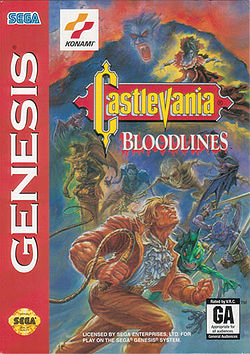- Castlevania: Bloodlines
-
Castlevania: Bloodlines
Castlevania: The New Generation
North American box artDeveloper(s) Konami Publisher(s) Konami Producer(s) Tomikazu Kirita Composer(s) Michiru Yamane Series Castlevania Platform(s) Mega Drive Release date(s) Genre(s) Platforming Mode(s) Single-player Rating(s) VRC: GA Castlevania: Bloodlines is the only Castlevania video game released on the Mega Drive/Genesis. It was developed and published by Konami, and was first released in North America, on March 17, 1994. Its Japanese title is Vampire Killer (バンパイアキラー Banpaia Kirā). This version featured a considerable amount of violence, with the American port containing a surprising amount of blood and gore for a game of its "GA" rating. The European and Australian titles were censored and both entitled Castlevania: The New Generation.
Contents
Gameplay
 Eric LeCarde, fighting the first miniboss, a Hellhound in Ruins of the Castle Dracula, Romania.
Eric LeCarde, fighting the first miniboss, a Hellhound in Ruins of the Castle Dracula, Romania.
As with most early Castlevania games, players proceed through each level, defeating enemies and collecting gems (hearts in previous games) to power special weapons (in this game, the axe, boomerang, and holy water). Each stage is sectioned into chunks, and has a sub-boss battle in the middle, with the big boss battle at the end. Some items will increase the power of the characters' weapons. Some portions of the game split into different paths, depending on which character is chosen. John is able to swing past huge gaps with his whip, whereas Eric must use a different route by performing high jumps by using his spear.
Bloodlines is also noteworthy for its abundance of special effects, such as the Atlantis Shrine's water reflections, the swaying tower of Pisa, and large multi-jointed bosses. The final stage even uses effects to add challenge, such as playing upside-down or playing while the screen divides up into sections. The "Item Crash" feature (from Akumajō Dracula X Chi no Rondo) makes its return in Bloodlines.
Plot
Setting
Unlike most Castlevania games, Bloodlines does not take place exclusively in Dracula's castle or even Romania. In addition to the first level – Dracula's castle in Romania – there are another five levels set in other European countries such as: in Athens in Greece, Pisa in Italy, a weapon factory in Germany, Versailles in France, and the fictional Castle Proserpina in England. Despite the change in setting, however, the game still features the now-archetypal designs of Castlevania games. The player starts in the ruins of Castlevania (the first half of which is taken from the first NES game), which is a recurring theme in later titles.
Characters
John Morris (ジョニー・モリス Johnny Morris): Born on December 12, 1895, in Texas, USA, is the current wielder of the Vampire Killer whip. "John Morris has been summoned by fate to slay the Countess Bartley before her diabolic plan can be fulfilled. Like all of his forefathers, he is wise in the ways of vampire slaying and is skilled with the legendary whip."[1]
Eric Lecarde (エリック・リカード): Born on May 3, 1892 in Segovia, Spain, he uses the Alcarde Spear (アルカード・スピア Alucard Spear). "Eric Lecarde, master lanceman, has volunteered to take his friend's place in the hunt. However, he hasn't told John the real reason behind his appetite for vengeance: the Countess turned the love of his life, Gwendolyn, into a vampire." [2]
Story
As stated in its introduction, the game takes place in 1917.
In 1897, the long war between humanity and Dracula came to an end, as Dracula was laid to eternal rest by Quincy Morris, a descendant of the Belmont family. Peace was restored to Europe, until the outbreak of the first World War, which transformed the continent into a dark world filled with massacre and violence. At the beginning of the war, on June 1914 at Sarajevo, the Crown Prince of Austria was assassinated. It was said that a strange beautiful woman was involved, within the shadows. It was Elizabeth Bartley (エリザベート・バートリー Elizabeth Báthory). In order to revive her uncle, Count Dracula, she conducted an unholy ceremony which caused the war, giving her possession of human souls from Europe.
And now, two silhouettes can be seen near Castle Dracula. John Morris, a descendant of the famed Belmont and Morris families who obeyed his fate to fight vampires day and night, and Eric Lecarde, whose girlfriend was transformed into a vampire when Elizabeth was revived. After Drolta Tzuentes (ドロテア・ツェンテス Dorothea Szentes) resurrected Elizabeth Bartley, they traveled across Europe to conduct the resurrection of Count Dracula. John Morris and Eric Lecarde followed them. Even though the resurrection of Dracula was a success, the vampire hunters defeated him, and his allies.
Textual references
This game attempts to bridge the Castlevania games with the Dracula novel written by Bram Stoker, which the series had only been loosely connected to previously, having arguably more in common with the 1931 Bela Lugosi film than the actual novel. The game even refers to one of the stars of the novel, Quincy Morris. In doing this, some plot points invented by the American localization staff of the game are openly contradicted.
According to the North American manual, John Morris (and his friend Eric Lecarde) were supposed to have witnessed his father's death moments after he had stabbed Dracula. At the time, John Morris was only two years of age, since he was born in 1895. Also, John and Eric were not mentioned in the novel. The original Japanese and European instruction manuals makes no mention of John and Eric being witness to his father's death. The novel describes the travelers who chase Dracula, but there is never a mention to any kids traveling with them. Nothing in the game contradicts the possibility of John witnessing his father's death, regardless of whether his age at the time prevented him from remembering the event.
The manual claims Quincy stabbed Dracula with a wooden stake. However, in the novel Quincy uses a Bowie Knife. Additionally, the manual claims it was Quincy Morris alone that killed Dracula, with no mention of the combined efforts of other characters in the novel. However, in the novel Dracula is killed when Jonathan Harker sliced through Dracula's throat (implying beheading), while Quincy simultaneously stabbed him through the heart.
Quincy attempts to court Lucy early in the novel, but it is not mentioned that Quincy has a two year old child (meaning, he either is in a relationship, or just got done with one). Though in Bram Stoker's version Quincy was intended to be a bachelor with no children.
Additionally, the Countess Bartley is loosely based on the actual historical figure Erzsébet Báthory. The witch who resurrects her in the game's backstory is Dorottya Szentes, who in reality had connections to Báthory. (Just as the name "Bartley" in the English versions of the game is a mistransliteration of Báthory, the name "Drolta Tzuentes" is a corruption of Dorottya's name.)
The game's backstory also references the real-life death of Archduke Franz Ferdinand of Austria, suggesting that the assassination had been ordered by the Countess.
Bloodlines' story weighs heavily on Portrait of Ruin, which stars John Morris' son Jonathan as the main character. John Morris dies sometime between 1917 and 1944 as a result of his reliance on the Vampire Killer whip and the fact that it saps the energy of its non-full-blood Belmont users (John had been injured in the fight with Dracula in 1917 and his reliance on the whip never allowed him to fully recover from his wounds).
Development
Castlevania: Bloodlines underwent censorship during localization to PAL regions in Europe and Australia. The word blood was kept out of the title at the time. Therefore, the title was altered to Castlevania: The New Generation. When the game starts, the blood from the bottom of the title screen was changed to water. Another thing that was changed for the title screen is that the North American and Japanese versions had blood dripping effects from the title to the blood pool, but in the European version, the title screen just faded in through pixailated text and had no blue water dripping effect. The zombies were changed from pink to green to make them less gruesome. In the European version, Eric's spear does not impale him after he dies. There was a rearrangement of enemy placement as well, making the difficulty either easier or harder depending on where in the game the player is. Also, only some sub-bosses use the life bar meter to show damage, whereas others don't.
Despite Australia being part of the PAL region, Sega Australia, the distributor of Konami's products on the Mega Drive used an uncensored version of The New Generation, with almost everything intact to be as close as possible to the Japanese version.
In the Japanese version, the title was simply Vampire Killer, and is much closer to its American counterpart than the PAL edit in terms of content. The "normal" mode is a bit less difficult than Bloodlines, with lower enemy appearance rate and more damage dealt. This version is also what accredited the "Drolta Tzuentes" edit. The character actually appears to fight during the final battle with Dracula to give him time to power up to his final form, whereas in the American version the sprite character is credited as being just another form of Dracula. Also, Eric's facial features were more feminine (i.e., bishōnen) in the Japanese version. When brought to North America, his facial design was changed in the intro to seem more masculine. Oddly, although also changed for the European and Australian versions intro, his feminine face was kept for the cover of those releases.
The game was originally released as a side story of Castlevania series.[1]
Audio
The music of Bloodlines was composed by Michiru Yamane, who garnered acclaim for her score for Castlevania: Symphony of the Night and subsequent handheld Castlevania adventures. Though she once admitted to have worked under extreme pressure and deadlines,[2] this soundtrack met the standards of the previous entries and is highly regarded on its own for its gloomy atmosphere.[citation needed] The music for the second level, titled "The Sinking Old Sanctuary," was reused in later Castlevania games, Circle of the Moon, for the Game Boy Advance, and Legacy of Darkness, for the Nintendo 64.
The main themes for each of the first levels of the three NES Castlevania games (Vampire Killer, Bloody Tears, Beginning) are accessible in-game with a code and can be played in the sound test as well. Also, Nothing to Lose (the Castle Keep theme for the NES Castlevania) was played in the final part of the first stage. Theme of Simon (from Super Castlevania IV) plays after defeating Elizabeth and before the battle with Dracula.
Reception
Reception Aggregate scores Aggregator Score GameRankings 81.88%[3] Review scores Publication Score References
- ^ Page 33, Rondo of Blood Strategy guide book
- ^ "It was my first title for the series ever, and I was under a lot a pressure." – Michiru Yamane, from the Castlevania: 20th Anniversary Deluxe Art Collection
- ^ http://www.gamerankings.com/genesis/563315-castlevania-bloodlines/index.html
Castlevania series List of media • Music in the Castlevania seriesMain series Castlevania • Vampire Killer • Simon's Quest • Haunted Castle • The Adventure • Dracula's Curse • Super Castlevania IV • Belmont's Revenge • Chronicles • Rondo of Blood • Bloodlines • Symphony of the Night • Legends • Castlevania (Nintendo 64) • Legacy of Darkness • Circle of the Moon • Harmony of Dissonance • Aria of Sorrow • Lament of Innocence • Dawn of Sorrow • Curse of Darkness • Portrait of Ruin • Order of Shadows • Order of Ecclesia • Judgment • The Arcade • The Adventure ReBirth • Harmony of Despair • Lords of ShadowSpin-off games Characters Staff Categories:- 1994 video games
- Castlevania games
- Sega Mega Drive games
- Sega Mega Drive-only games
- Video games developed in Japan
- Video games set in the 1910s
Wikimedia Foundation. 2010.

